Integrated Metabolomic and Transcriptomic Analysis of Acute Kidney Injury Caused by Leptospira Infection
Abstract
1. Introduction
2. Results
2.1. Characterisation of Urine Metabolite Trends in Leptospiral-Infected Mice Using LC-TOFMS-Based Metabolomics
2.2. Pathological Analysis of Renal Injury in the Different Groups of Mice at Day 7
2.3. Urinary Metabolites in Leptospira spp.-Infected Mice in the First Week
2.4. RNA-Seq-Based Transcriptomics for Functional Pathway Analysis
2.5. Integrated Pathway-Level Analysis of Transcriptomic and Metabolomics Data
3. Discussion
4. Materials and Methods
4.1. Bacterial Culture
4.2. Mouse Model for Leptospiral Infection
4.3. Urine Sample Extraction for Metabolomics Analysis
4.4. Kidney Tissue Preparation
4.5. Histopathological Analysis of the Kidneys
4.6. Liquid Chromatography/Time-of-Flight Mass Spectrometry (LC/TOFMS) Analysis
4.7. Data Processing
4.8. Metabolite Identification
4.9. High-Throughput RNA-Sequencing (RNA-Seq) and Bioinformatics Analysis
4.10. Statistical Analysis
5. Conclusions
Supplementary Materials
Author Contributions
Funding
Institutional Review Board Statement
Informed Consent Statement
Data Availability Statement
Acknowledgments
Conflicts of Interest
References
- Costa, F.; Hagan, J.E.; Calcagno, J.; Kane, M.; Torgerson, P.; Martinez-Silveira, M.S.; Stein, C.; Abela-Ridder, B.; Ko, A.I. Global Morbidity and Mortality of Leptospirosis: A Systematic Review. PLoS Negl. Trop. Dis. 2015, 9, e0003898. [Google Scholar] [CrossRef] [PubMed]
- Yang, C.W.; Wu, M.S.; Pan, M.J. Leptospirosis renal disease. Nephrol. Dial. Transplant. 2001, 16 (Suppl. 5), 73–77. [Google Scholar] [CrossRef] [PubMed]
- Yang, C.W. Leptospirosis Renal Disease: Emerging Culprit of Chronic Kidney Disease Unknown Etiology. Nephron 2018, 138, 129–136. [Google Scholar] [CrossRef] [PubMed]
- Ratet, G.; Veyrier, F.J.; Fanton d’Andon, M.; Kammerscheit, X.; Nicola, M.A.; Picardeau, M.; Boneca, I.G.; Werts, C. Live imaging of bioluminescent Leptospira interrogans in mice reveals renal colonization as a stealth escape from the blood defenses and antibiotics. PLoS Negl. Trop. Dis. 2014, 8, e3359. [Google Scholar] [CrossRef]
- Yang, H.Y.; Hung, C.C.; Liu, S.H.; Guo, Y.G.; Chen, Y.C.; Ko, Y.C.; Huang, C.T.; Chou, L.F.; Tian, Y.C.; Chang, M.Y.; et al. Overlooked Risk for Chronic Kidney Disease after Leptospiral Infection: A Population-Based Survey and Epidemiological Cohort Evidence. PLoS Negl. Trop. Dis. 2015, 9, e0004105. [Google Scholar] [CrossRef]
- Gomes-Solecki, M.; Santecchia, I.; Werts, C. Animal Models of Leptospirosis: Of Mice and Hamsters. Front. Immunol. 2017, 8, 58. [Google Scholar] [CrossRef]
- Chassin, C.; Picardeau, M.; Goujon, J.-M.; Bourhy, P.; Quellard, N.; Darche, S.; Badell, E.; D’Andon, M.F.; Winter, N.; Lacroix-Lamandé, S.; et al. TLR4- and TLR2-Mediated B Cell Responses Control the Clearance of the Bacterial Pathogen, Leptospira interrogans. J. Immunol. 2009, 183, 2669–2677. [Google Scholar] [CrossRef]
- Lacroix-Lamandé, S.; D’Andon, M.F.; Michel, E.; Ratet, G.; Philpott, D.J.; Girardin, S.E.; Boneca, I.G.; Vandewalle, A.; Werts, C. Downregulation of the Na/K-ATPase Pump by Leptospiral Glycolipoprotein Activates the NLRP3 Inflammasome. J. Immunol. 2012, 188, 2805–2814. [Google Scholar] [CrossRef]
- Fanton d’Andon, M.; Quellard, N.; Fernandez, B.; Ratet, G.; Lacroix-Lamandé, S.; Vandewalle, A.; Boneca, I.G.; Goujon, J.M.; Werts, C. Leptospira interrogans induces fibrosis in the mouse kidney through Inos-dependent, TLR- and NLR-independent signaling pathways. PLoS Negl. Trop Dis. 2014, 8, e2664. [Google Scholar] [CrossRef]
- Fraga, T.R.; Isaac, L.; Barbosa, A.S. Complement Evasion by Pathogenic Leptospira. Front. Immunol. 2016, 7, 623. [Google Scholar] [CrossRef]
- Matsui, M.; Roche, L.; Geroult, S.; Soupé-Gilbert, M.-E.; Monchy, D.; Huerre, M.; Goarant, C. Cytokine and Chemokine Expression in Kidneys during Chronic Leptospirosis in Reservoir and Susceptible Animal Models. PLoS ONE 2016, 11, e0156084. [Google Scholar] [CrossRef]
- Chou, L.F.; Chen, T.W.; Yang, H.-Y.; Chang, M.-Y.; Hsu, S.-H.; Tsai, C.-Y.; Ko, Y.-C.; Huang, C.-T.; Tian, Y.-C.; Hung, C.-C.; et al. Murine Renal Transcriptome Profiles Upon Leptospiral Infection: Implications for Chronic Kidney Diseases. J. Infect. Dis. 2018, 218, 1411–1423. [Google Scholar] [CrossRef] [PubMed]
- Kutmon, M.; van Iersel, M.P.; Bohler, A.; Kelder, T.; Nunes, N.; Pico, A.; Evelo, C.T. PathVisio 3: An Extendable Pathway Analysis Toolbox. PLoS Comput. Biol. 2015, 11, e1004085. [Google Scholar] [CrossRef]
- Schwedhelm, E.; Boger, R.H. The role of asymmetric and symmetric dimethylarginines in renal disease. Nat. Rev. Nephrol. 2011, 7, 275–285. [Google Scholar] [CrossRef] [PubMed]
- El-Khoury, J.M.; Bunch, D.R.; Hu, B.; Payto, D.; Reineks, E.Z.; Wang, S. Comparison of symmetric dimethylarginine with creatinine, cystatin C and their eGFR equations as markers of kidney function. Clin. Biochem. 2016, 49, 1140–1143. [Google Scholar] [CrossRef]
- Mutsaers, H.A.M.; van den Heuvel, L.P.; Ringens, L.H.J.; Dankers, A.C.A.; Russel, F.G.M.; Wetzels, J.F.M.; Hoenderop, J.G.; Masereeuw, R. Uremic Toxins Inhibit Transport by Breast Cancer Resistance Protein and Multidrug Resistance Protein 4 at Clinically Relevant Concentrations. PLoS ONE 2011, 6, e18438. [Google Scholar] [CrossRef] [PubMed]
- Martin-Lorenzo, M.; Gonzalez-Calero, L.; Ramos-Barron, A.; Sanchez-Niño, M.D.; Gomez-Alamillo, C.; García-Segura, J.M.; Ortiz, A.; Arias, M.; Vivanco, F.; Alvarez-Llamas, G. Urine metabolomics insight into acute kidney injury point to oxidative stress disruptions in energy generation and H2S availability. J. Mol. Med. 2017, 95, 1399–1409. [Google Scholar] [CrossRef]
- Zager, R.A.; Johnson, A.C.M. Acute kidney injury induces dramatic p21 upregulation via a novel, glucocorticoid-activated, pathway. Am. J. Physiol. Renal. Physiol. 2019, 316, F674–F681. [Google Scholar] [CrossRef]
- Weinberg, J.M. Mitochondrial Biogenesis in Kidney Disease. J. Am. Soc. Nephrol. 2011, 22, 431–436. [Google Scholar] [CrossRef]
- Uzel, B.; Altiparmak, M.R.; Ataman, R.; Serdengeçti, K. Acute renal failure due to carnitine palmitoyltransferase II deficiency. Neth. J. Med. 2003, 61, 417–420. [Google Scholar]
- Wanner, C.; Riegel, W.; Schaefer, R.M.; Hörl, W.H. Carnitine and Carnitine Esters in Acute Renal Failure. Nephrol. Dial. Transplant. 1989, 4, 951–956. [Google Scholar] [CrossRef] [PubMed]
- Wei, Q.; Xiao, X.; Fogle, P.; Dong, Z. Changes in metabolic profiles during acute kidney injury and recovery following ischemia/reperfusion. PLoS ONE 2014, 9, e106647. [Google Scholar] [CrossRef] [PubMed]
- Szeto, H.H. Pharmacologic Approaches to Improve Mitochondrial Function in AKI and CKD. J. Am. Soc. Nephrol. 2017, 28, 2856–2865. [Google Scholar] [CrossRef] [PubMed]
- Qiu, J.; Ma, Y.; Chen, L.; Wu, L.; Wen, Y.; Liu, W. A sirA-like gene, sirA2, is essential for 3-succinoyl-pyridine metabolism in the newly isolated nicotine-degrading Pseudomonas sp. HZN6 strain. Appl. Microbiol. Biotechnol. 2011, 92, 1023–1032. [Google Scholar] [CrossRef]
- Časaitė, V.; Stanislauskienė, R.; Vaitekūnas, J.; Tauraitė, D.; Rutkienė, R.; Gasparavičiūtė, R.; Meškys, R. Microbial Degradation of Pyridine: A Complete Pathway in Arthrobacter sp. Strain 68b Deciphered. Appl Environ Microbiol. 2020, 86, e00902-20. [Google Scholar] [CrossRef]
- Pavia, C.S.; Plummer, M.M. Clinical implications of nicotine as an antimicrobial agent and immune modulator. Biomed. Pharmacother. 2020, 129, 110404. [Google Scholar] [CrossRef]
- Groth, B.; Venkatakrishnan, P.; Lin, S.J. NAD(+) Metabolism, Metabolic Stress, and Infection. Front. Mol. Biosci. 2021, 8, 686412. [Google Scholar] [CrossRef]
- Ralto, K.M.; Rhee, E.P.; Parikh, S.M. NAD+ homeostasis in renal health and disease. Nat. Rev. Nephrol. 2020, 16, 99–111. [Google Scholar] [CrossRef]
- Dobrek, L.; Arent, Z.; Nalik-Iwaniak, K.; Fic, K.; Kopańska, M. Osteopontin and Fatty Acid Binding Protein in Ifosfamide-treated Rats. Open Med. 2019, 14, 561–571. [Google Scholar] [CrossRef]
- Araujo, A.M.; Noronha-Dutra, A.; Reis, E.A.G.; Couto, N.S.; Reis, M.G.; Ko, A.; Araujo, G.C.; Ribeiro, G.; Damião, A.O.; Athanazio, D.A.; et al. Oxidative Stress Markers Correlate with Renal Dysfunction and Thrombocytopenia in Severe Leptospirosis. Am. J. Trop. Med. Hyg. 2014, 90, 719–723. [Google Scholar] [CrossRef][Green Version]
- Gazi, I.F.; Apostolou, F.A.; Liberopoulos, E.N.; Filippatos, T.D.; Tellis, C.C.; Elisaf, M.S.; Tselepis, A.D. Leptospirosis is Associated with Markedly Increased Triglycerides and Small Dense Low-Density Lipoprotein and Decreased High-Density Lipoprotein. Lipids 2011, 46, 953–960. [Google Scholar] [CrossRef] [PubMed]
- Santos, C.S.; Macedo, J.O.; Bandeira, M.; Chagas-Junior, A.D.; McBride, A.J.A.; McBride, F.W.C.; Reis, M.G.; Athanazio, D.A. Different outcomes of experimental leptospiral infection in mouse strains with distinct genotypes. J. Med. Microbiol. 2010, 59 Pt 9, 1101–1106. [Google Scholar] [CrossRef] [PubMed]
- Shackelford, C.; Long, G.; Wolf, J.; Okerberg, C.; Herbert, R. Qualitative and Quantitative Analysis of Nonneoplastic Lesions in Toxicology Studies. Toxicol. Pathol. 2002, 30, 93–96. [Google Scholar] [CrossRef] [PubMed]
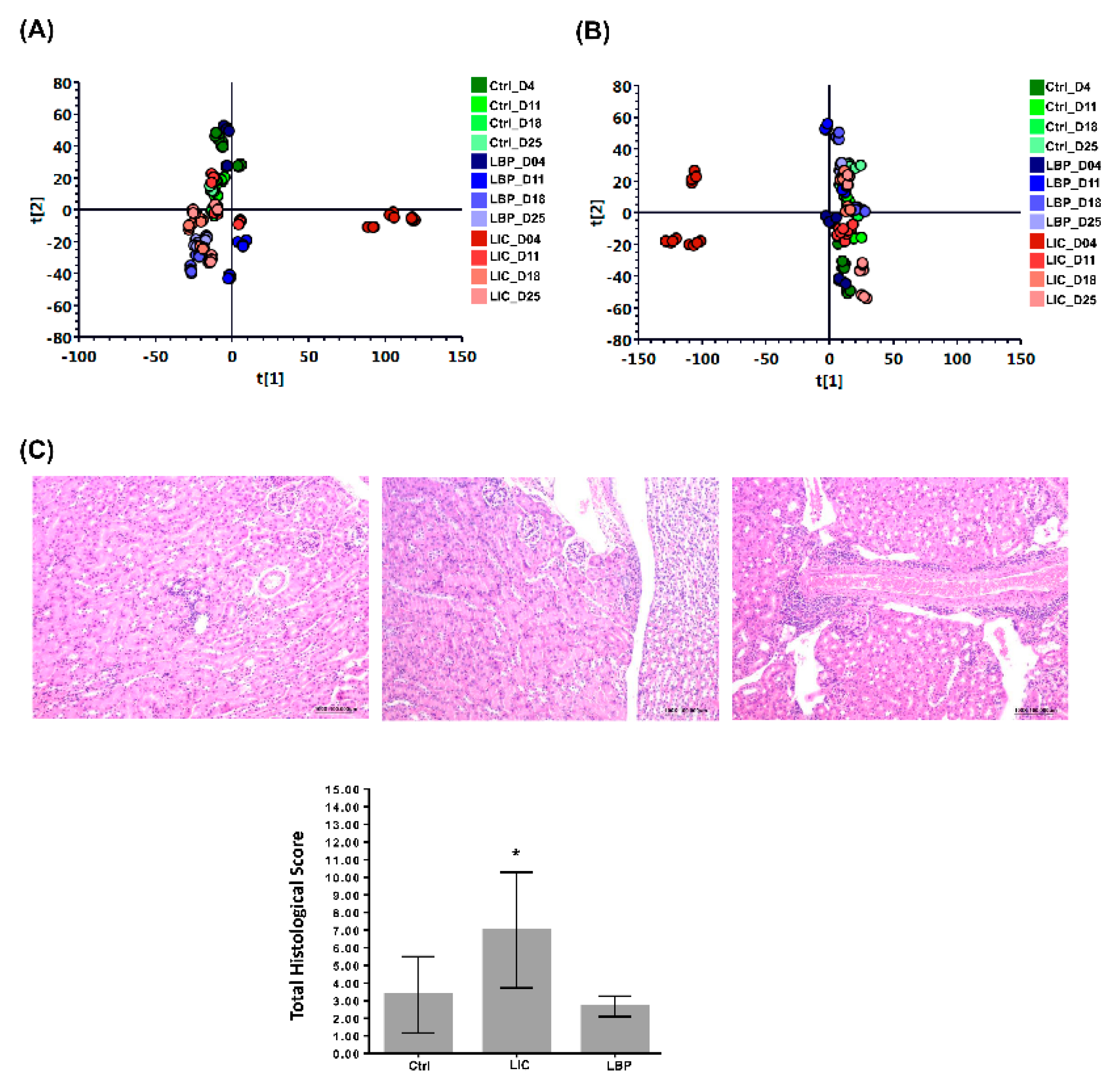

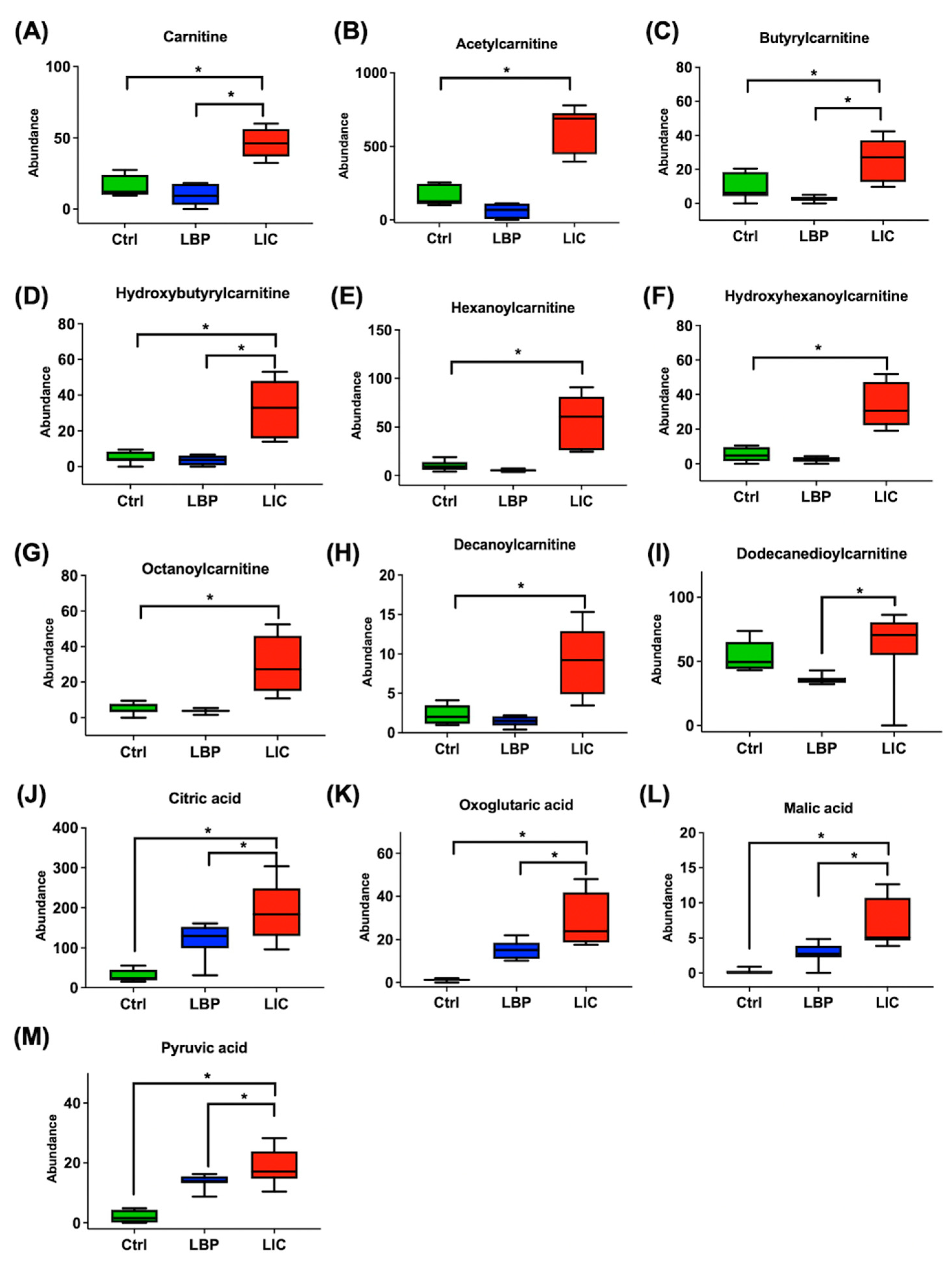

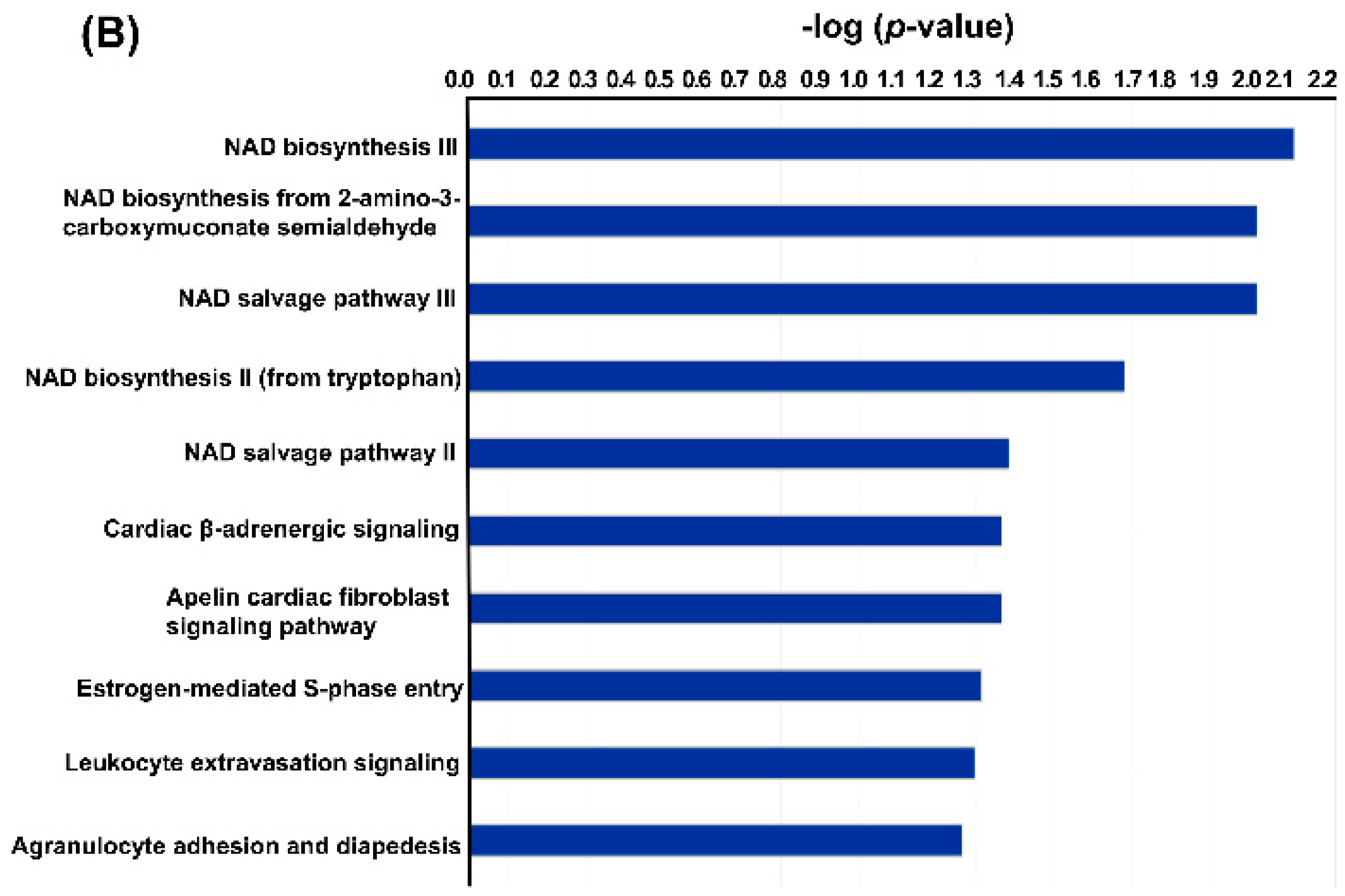
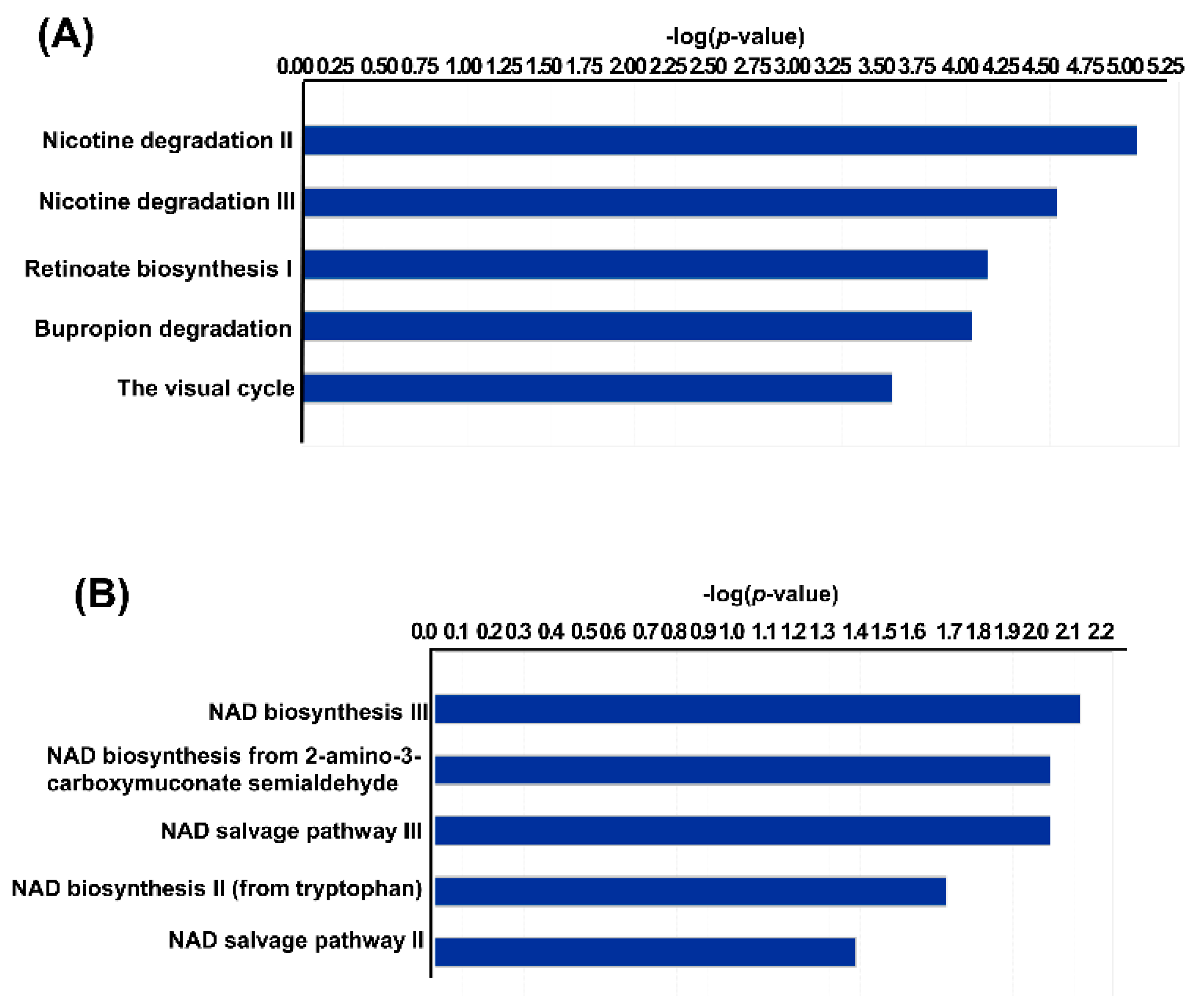
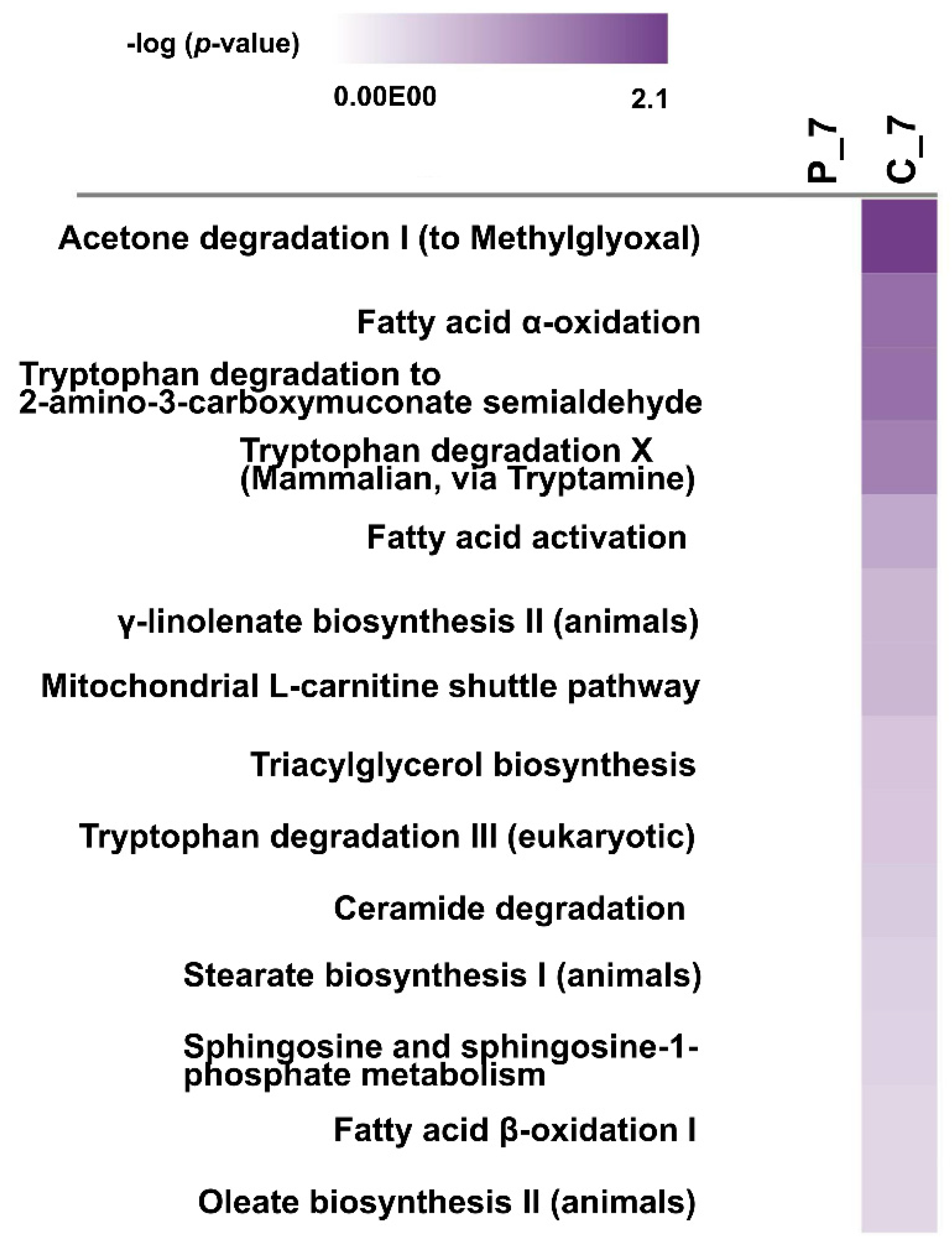
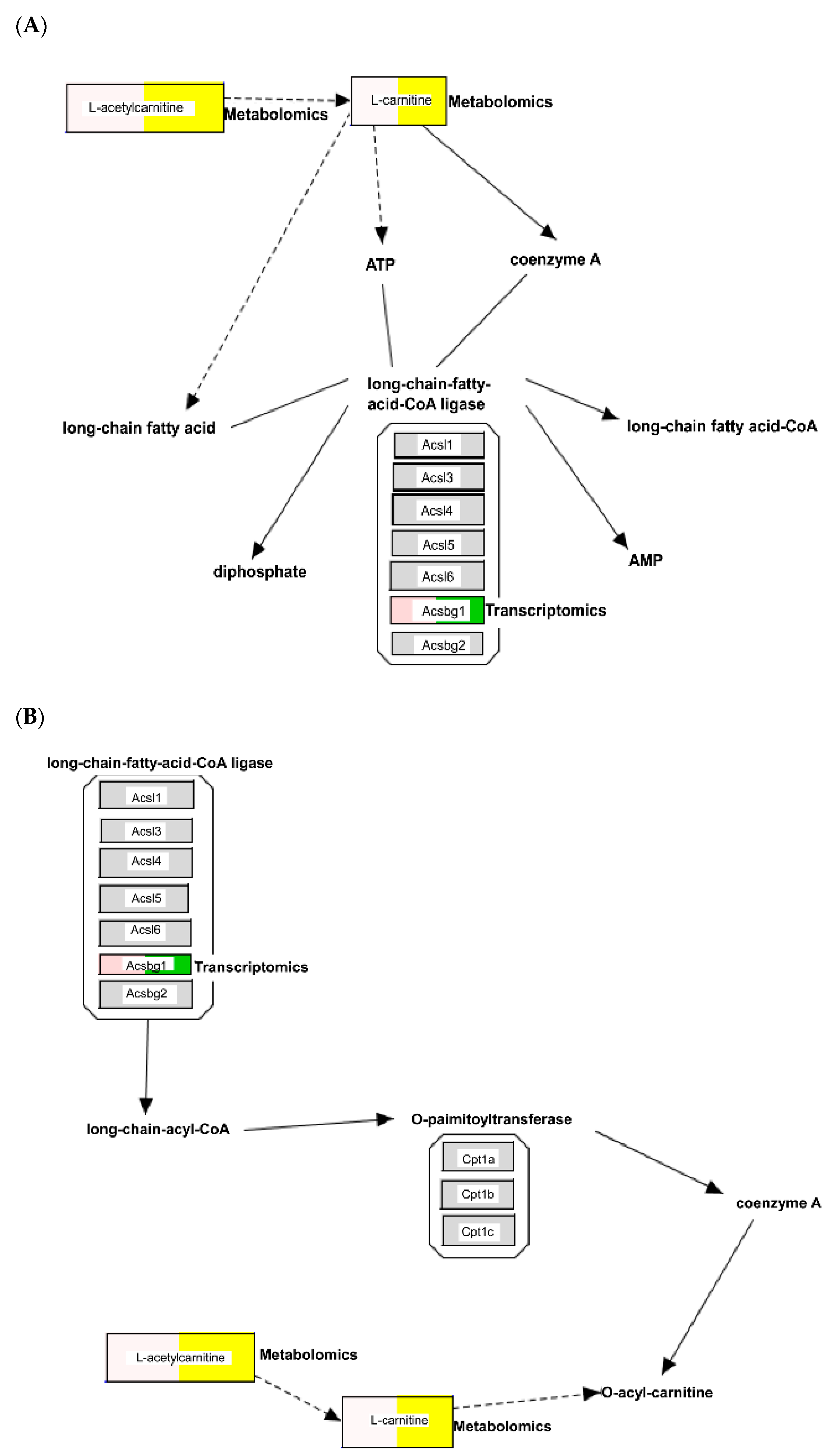
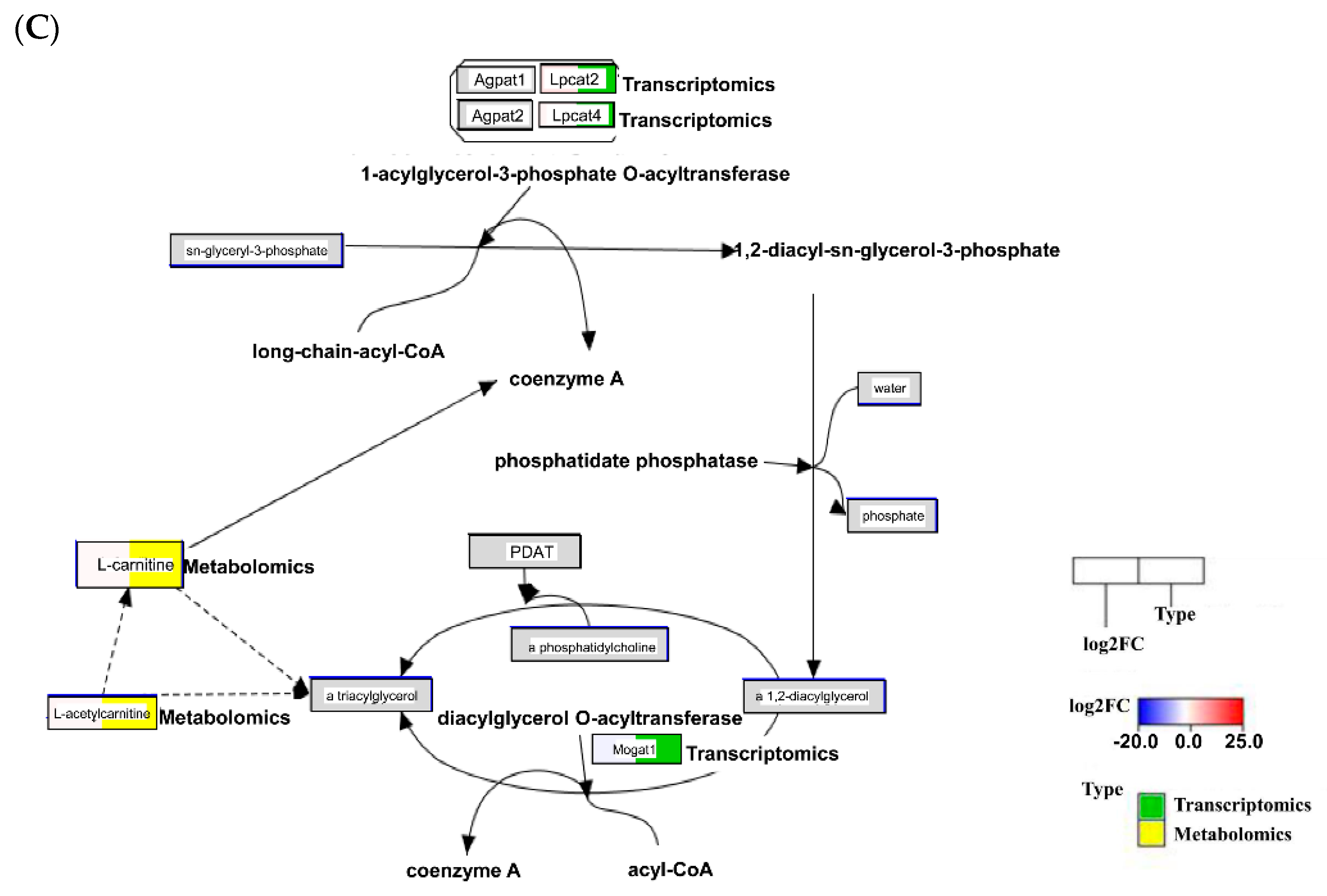
| Measurements a Groups | |||
|---|---|---|---|
| Without Infection | Pathogenic L. interrogans Infection | Nonpathogenic L. biflexa Infection | |
| Inflammatory cell infiltration | 1.00 ± 0.89 | 2.33 ± 1.03 | 1.00 ± 0.00 |
| Degeneration/necrosis | 0.83 ± 0.75 | 1.67 ± 1.03 | 0.67 ± 0.58 |
| Tubular dilation | 1.33 ± 0.82 | 2.33 ± 0.82 | 1.00 ± 0.00 |
| Fibrosis | 0.17 ± 0.41 | 0.67 ± 1.03 | 0.00 ± 0.00 |
| Total histological score | 3.33 ± 2.16 | 7.00 ± 3.29 | 2.67 ± 0.58 |
Publisher’s Note: MDPI stays neutral with regard to jurisdictional claims in published maps and institutional affiliations. |
© 2022 by the authors. Licensee MDPI, Basel, Switzerland. This article is an open access article distributed under the terms and conditions of the Creative Commons Attribution (CC BY) license (https://creativecommons.org/licenses/by/4.0/).
Share and Cite
Chen, K.-H.; Chou, L.-F.; Hung, C.-C.; Tang, H.-Y.; Cheng, M.-L.; Yang, H.-Y.; Hsu, H.-H.; Tian, Y.-C.; Yang, C.-W. Integrated Metabolomic and Transcriptomic Analysis of Acute Kidney Injury Caused by Leptospira Infection. Pathogens 2022, 11, 764. https://doi.org/10.3390/pathogens11070764
Chen K-H, Chou L-F, Hung C-C, Tang H-Y, Cheng M-L, Yang H-Y, Hsu H-H, Tian Y-C, Yang C-W. Integrated Metabolomic and Transcriptomic Analysis of Acute Kidney Injury Caused by Leptospira Infection. Pathogens. 2022; 11(7):764. https://doi.org/10.3390/pathogens11070764
Chicago/Turabian StyleChen, Kuan-Hsing, Li-Fang Chou, Cheng-Chieh Hung, Hsiang-Yu Tang, Mei-Ling Cheng, Huang-Yu Yang, Hsiang-Hao Hsu, Ya-Chung Tian, and Chih-Wei Yang. 2022. "Integrated Metabolomic and Transcriptomic Analysis of Acute Kidney Injury Caused by Leptospira Infection" Pathogens 11, no. 7: 764. https://doi.org/10.3390/pathogens11070764
APA StyleChen, K.-H., Chou, L.-F., Hung, C.-C., Tang, H.-Y., Cheng, M.-L., Yang, H.-Y., Hsu, H.-H., Tian, Y.-C., & Yang, C.-W. (2022). Integrated Metabolomic and Transcriptomic Analysis of Acute Kidney Injury Caused by Leptospira Infection. Pathogens, 11(7), 764. https://doi.org/10.3390/pathogens11070764







